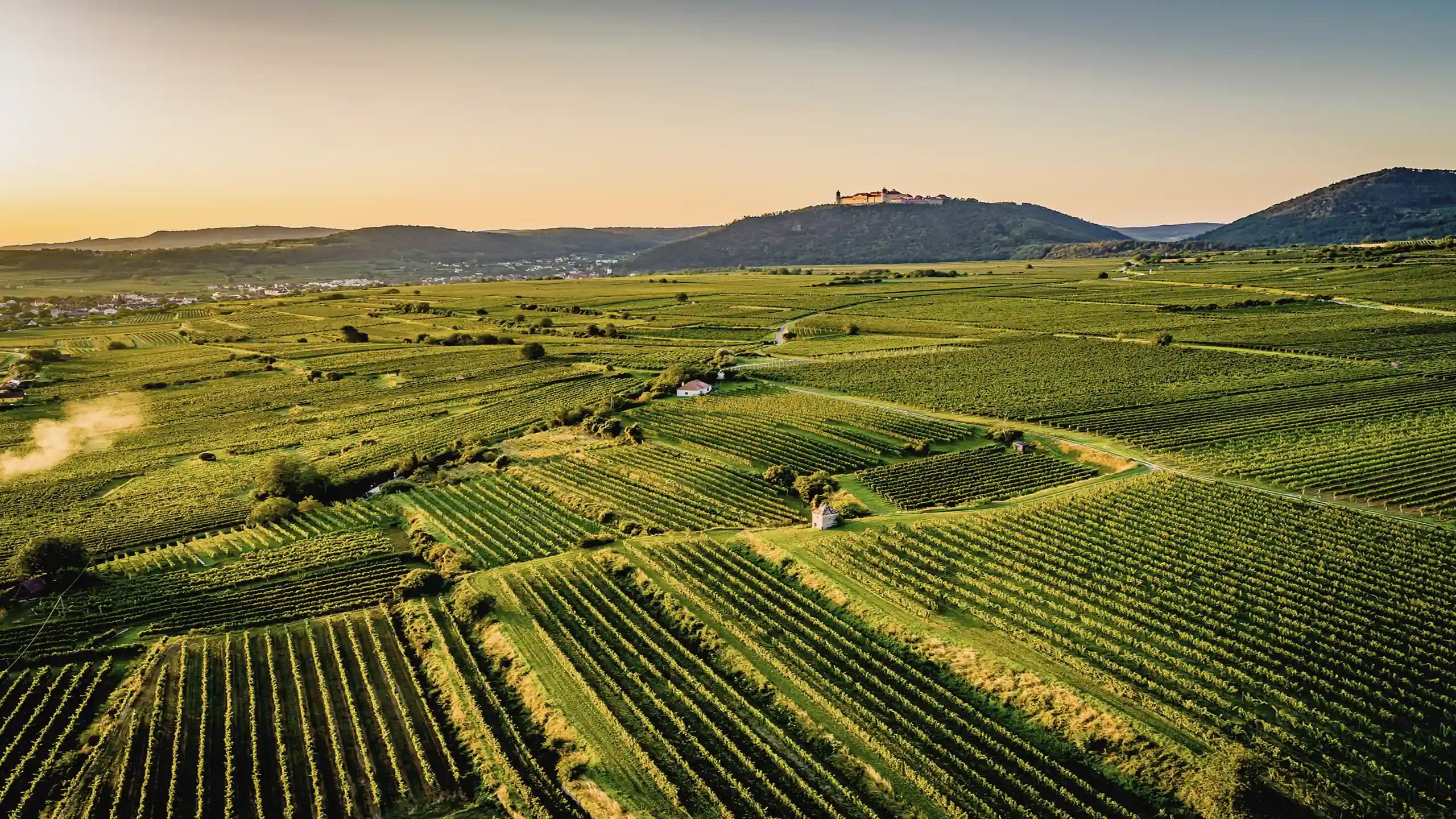ORIGIN OF HEAVENLY WINES
The Terroir on Göttweiger Berg
For many centuries, the unique terroir of Göttweiger Berg has shaped our historic wine-growing region. The soils and climate create ideal conditions for first-class wines – a precious heritage that we preserve and express in our wines.
JEWELS OF HISTORIC VINEYARDS
Stift Göttweig's most precious sites -
small origins of the greatest quality
Our most valuable vineyards are situated on the Göttweiger Berg – developed centuries ago, protected for generations, and constant sources of exceptional qualities which significantly reflect the origin of the southern Kremstal.
PURE GÖTTWEIGER BERG
Ried Gottschelle – at the foot of Göttweiger Berg

MAX 32° | Ø 3°
Slope
216 – 272 m
Altitude
N (22%), NE (43%), E (10%)
Orientation
Grüner Veltliner
Variety
At the foot of the Göttweiger Berg lies this gently northeast-facing site on a plateau of old Danube terraces. Deep, calcareous loess-loam mixed with Danube gravel provides nutrient-rich soil – ideal conditions for Grüner Veltliner. The landscape is characterized by loess walls up to twelve meters high, in whose cavities the colorful and rare bee-eater breeds. The vineyard was first mentioned in 1341 as 'Gotschalich'.

0,75 Liter 2024 Ried Gottschelle 1.ÖTW Kremstal DAC Grüner Veltliner
Gottschelle has always been the classic for full-bodied Grüner Veltliners full of typicity. Dense, subtle, and blessed with a long-lasting finish.
To the wine ▸WHERE GREAT ORIGINS MERGE
Ried Silberbichl – the shimmering source of radiant wines

MAX 17° | Ø 3°
Slope
207 – 254 m
Altitude
N (42%), NE (22%)
Orientation
Riesling
Variety
Here the Danube deposited sediments, which were laid down as large terraces and covered with calcareous loess-loam. In deep soil horizons, mica comes to light, which gives the name mentioned in 1562 as 'Silberpiegl' its meaning – it shimmers silvery in the evening sun. The fertile and water-retentive soils are the basis of radiant wines. A unique site that connects the two wine-growing areas of Wachau and Kremstal.

0,75 Liter 2024 Ried Silberbichl 1.ÖTW Kremstal DAC Riesling
Silberbichl is known as the shimmering source of bright and refined Rieslings.
To the wine ▸COUNTERPOINT TO GÖTTWEIGER BERG
Ried Pfaffenberg – an icon of Austrian vineyards

MAX 58° | Ø 19°
Slope
199 – 378 m
Altitude
SE (75%), S (13%), SW (7%)
Orientation
Riesling
Variety
Located directly on the Danube, this extremely steep, southeast-facing terraced site rises to an altitude of 360 meters. The barren rock subsoil of Gföhl gneiss, mica schist, and amphibolite shapes the appearance and resembles a coastal cliff. Strong winds and cool nights shape the microclimate. The sparse soils allow Riesling, in particular, with marked minerality to thrive. First mentioned in the 13th century as 'mons clericorum'. Our only site on the left bank of the Danube.

0,75 Liter 2024 Ried Pfaffenberg 1.ÖTW Kremstal DAC Riesling
Smoky, mineral, and more complex than all the other wines in our range. A must-have Riesling for special moments.
To the wine ▸BENEDICTINE HERITAGE
Precious Kremstal – Origin with Diversity
Stift Göttweig and the Benedictines have shaped viticulture in the Kremstal since 1094. Comprehensive knowledge of the best vineyards has been accumulated over centuries. Winemakers in the Kremstal draw from this wealth of knowledge about these special sites.

Soil
Göttweig's soils - a journey through geological history
The soils near Göttweig are primarily characterized by calcareous loess, which was blown in from the Alps 10,000 years ago. Locally, you can also find granulite and mica schist around Göttweig, which are metamorphic rocks that formed more than 300 million years ago. The sites in the valley floor consist of sediments from the ancient Danube.

Climate
Stift Göttweig - situated in a climatic field of tension
On one hand, warm currents from the Pannonian Basin reach into the Kremstal. The Dunkelsteinerwald with its cold air currents provides a climatic contrast. These strong day-night fluctuations promote the aromatic ripening of the grapes. Furthermore, the Danube valley brings an interplay of wind and humidity.

Region
Our vineyards are located in the southern part of the Kremstal wine region, around the Göttweiger Berg, which has an altitude of 423m and from where you can enjoy a view of the Dunkelsteinerwald, the Danube, Krems, the Waldviertel, and the Wagram. Here the Danube valley opens up and the steep rocky slopes transition into a hilly landscape.

Kremstal DAC
Only wines of the Grüner Veltliner and Riesling grape varieties may be marketed as Kremstal DAC, which are also classified as regional, village, and vineyard wines. The designation "Reserve" defines a more opulent style, which is characterized by fully ripe grapes and long storage in the cellar.




